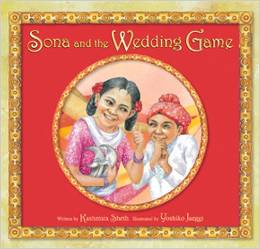Contribute
| Sona And The Wedding Game |
Book review by Tara Menon
06/02/2015
Sona and the Wedding Game
by Kashmira Sheth
Peachtree Publishers
April 2015
Review of Sona and the Wedding Game
by Tara Menon
We all know the story of Cinderella, whose glassy slipper led the prince to the woman he wanted to marry. The fairy tale ends with their wedding and the readers know they will live happily ever. In Kashmira Sheth’s Sona and the Wedding Game the plot concerns a pair of bridegroom shoes that will be stolen, not by a wicked witch but by a child at her own grandmother’s request. Dadima is no evil crone; she wants to make sure an important wedding tradition will be upheld. Sheth was inspired to write the picture book after looking at photos of her daughter’s wedding. She captures the fun and flavor of a Hindu wedding and simultaneously imparts an appreciation of the deeper meaning of the ceremony and rituals associated with it.
As in her two previous picture books for four to eight-year-olds, My Dadima Wears a Sari and Monsoon Afternoon, the story line features a grandparent and a narrator grandchild and demonstrates the fun aspect of one’s heritage passed down through the generations. The cast in Sona and the Wedding Game encompasses two families though contemplative, imaginative Sona and her cousin, Vishal, are the two main characters.
The story begins when Sona’s grandparents and her cousin arrive in America to attend her sister’s wedding. There is much to do to prepare for the wedding. Dadima tells Sona that custom dictates the bride’s sister should steal the bridegroom’s shoes. The bride warns her sister that the bridegroom’s brother, Jitu, will be guarding his shoes. Sona wonders whether she’ll recognize him since she’s only met him once. The protagonist is inquisitive as she’s never been to a wedding and she gasps when she learns the bridegroom will arrive for the ceremony on a white horse. The pre-wedding activities, essential in such a story, build the gentle momentum and acquaint young readers with festive customs like readying the house with rangoli patterns and holding a mehndi party. However, the lightness of such occasions is always countered with jitters, in this case felt by the bride’s sister. How will she steal the shoes? “Could I dress up as a robber and snatch them? Or dump red kumkum powder on Jitu to distract him?†Finally, she enlists the help of annoying, know-it-all Vishal to carry out her secret plan.
The ceremony unfolds with a few deft strokes of prose, enough for us to grasp some lovely wedding touches, like the priest inviting the whole universe to the event, including the “rivers and mountains, planets and stars, sun and moon.†(One can’t help but appreciate this detail in our increasingly environmentally conscious times.) Meanwhile we wonder how Sona will get the shoes from Jitu’s bag. Aided by Vishal, she does it with aplomb.
Yoshiko Jaeggi, the illustrator, has teamed up with Sheth for the third time in Sona and the Wedding Game and, as before, she complements and enhances the story. Her pictures provide a riot of colors, unlike in Monsoon Afternoon, in which blues and greens suitably dominated the color palette. The illustrations help the reader understand the festive customs and the wedding ceremony. Unfortunately, the wedding sari, described as “red-gold,†is merely red and white in a couple of pictures and with scarcely any red-gold in the others. My favorite watercolor depictions are one of Dadima braiding her hair (or fancy braiding as the protagonist would say) and the last illustration in the story, which shows a gleeful Sona with her prize (one she pluckily negotiates with the groom). The latter would have made a terrific cover, but for the fact that it would have been a giveaway. The actual picture on the cover shows the heart of the theme – Sona conspiring with Vishal.
The author’s note at the end of the book tells us that, though Sheth attended a couple of weddings as a child (her aunt’s and a princess’s), she never had to steal the bridegroom’s shoes because she didn’t have any older siblings. She explains that not all Hindu weddings involve this custom. Sheth strikes the balance between not overburdening the reader with material to make sense of the story, but at the same time letting us know enough to appreciate her tale.
You may also access this article through our web-site http://www.lokvani.com/
